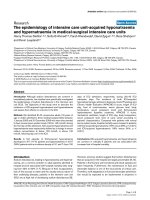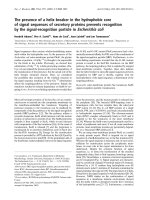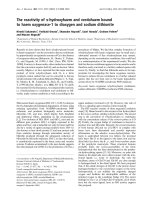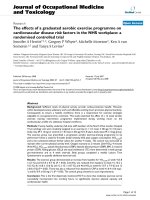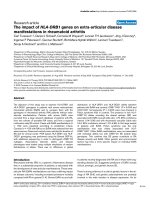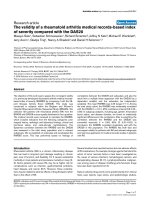Báo cáo y học: "The Impact of a Nationwide Antibiotic Restriction Program on Antibiotic Usage and Resistance against Nosocomial Pathogens in Turkey"
Bạn đang xem bản rút gọn của tài liệu. Xem và tải ngay bản đầy đủ của tài liệu tại đây (355.31 KB, 6 trang )
Int. J. Med. Sci. 2011, 8
339
I
I
n
n
t
t
e
e
r
r
n
n
a
a
t
t
i
i
o
o
n
n
a
a
l
l
J
J
o
o
u
u
r
r
n
n
a
a
l
l
o
o
f
f
M
M
e
e
d
d
i
i
c
c
a
a
l
l
S
S
c
c
i
i
e
e
n
n
c
c
e
e
s
s
2011; 8(4):339-344
Research Paper
The Impact of a Nationwide Antibiotic Restriction Program on Antibiotic
Usage and Resistance against Nosocomial Pathogens in Turkey
Adalet Altunsoy
1
, Cenk Aypak
2
, Alpay Azap
1
, Önder Ergönül
3
, İsmail Balık
1
1. Department of Clinical Microbiology and Infectious Disease, Ankara University, School of Medicine, Ibni Sina Hospital
06100, Ankara, Turkey
2. Department of Family Medicine, Ankara University, School of Medicine, Ibni Sina Hospital 06100, Ankara, Turkey
3. Department of Clinical Microbiology and Infectious Disease, Marmara University, School of Medicine, 34662, Istanbul,
Turkey
Corresponding author: ; Tel: +90 505 6452780; Fax: +90 312 3240328
© Ivyspring International Publisher. This is an open-access article distributed under the terms of the Creative Commons License (
licenses/by-nc-nd/3.0/). Reproduction is permitted for personal, noncommercial use, provided that the article is in whole, unmodified, and properly cited.
Received: 2011.02.22; Accepted: 2011.05.16; Published: 2011.05.24
Abstract
Purpose: Antimicrobial resistance among microorganisms is a global concern. In 2003, a
nationwide antibiotic restriction program (NARP) was released in Turkey. In this study
we evaluated the effect of NARP on antibiotic consumption, antimicrobial resistance, and
cost.
Materials and Methods: The data obtained from all of the four university hospitals, and
one referral tertiary-care educational state hospital in Ankara. Antimicrobial resistance
profiles of 14,233 selected microorganisms all grown in blood cultures and antibiotic
consumption from 2001 to 2005 were analyzed retrospectively.
Results: A negative correlation was observed between the ceftriaxone consumption and
the prevalence of ceftriaxone resistant E.coli and Klebsiella spp. (rho:-0.395, p:0.332 and
rho:-0.627, p:0.037, respectively). The decreased usage of carbapenems was correlated
with decreased carbapenems-resistant Pseudomonas spp. and Acinetobacter spp (rho:0.155,
p:0.712 and rho:0.180, p:0.668, respectively for imipenem). Methicillin resistance rates of
S.aureus were decreased from 44% to 41%. After two years of NARP 5,389,155.82 USD
saving occurred.
Conclusion: NARP is effective in lowering the costs and antibiotic resistance.
Key words: Antibiotic consumption, antimicrobial resistance surveillance, restriction policy.
Introduction
It is obvious that antibiotics had saved many
lives since they were first introduced to medical prac-
tice. However, when antibiotics are used the emer-
gence of drug resistant microorganisms is inevitable.
The emergence of resistant microorganisms becomes
faster when antibiotic use is inappropriate [1]. As well
as emergence of resistant microorganisms, increased
mortality and morbidity, adverse drug reactions and
excessive strain on already limited healthcare budgets
are the results of inappropriate antibiotic consump-
tion [2-4].
These findings provide compelling evidence
of the need for more rational use of antimicrobial
agents in all over the world [5-9]. In order to slow-
down the development and dissemination of resistant
bacteria, restrictions on antibiotic prescribing are be-
coming more widespread [10].
In February 2003, Turkish Ministry of Health
released a nationwide regulation for antibiotic re-
Ivyspring
International Publisher
Int. J. Med. Sci. 2011, 8
340
striction. According to nationwide antibiotic re-
striction program (NARP), carbapenems, glycopep-
tids, piperacillin/tazobactam, ticarcillin/clavulanate
were considered as restricted antibiotics that could be
used only with the approval of an infectious disease
specialist (IDS). Parenteral quinolones, 3(rd) and 4(th)
generation cephalosporins, netilmisin, amikacin could
still be prescribed by all specialists just for the first 72
h of treatment but further utilization required IDS
approval.
In this multicenter study we aimed to assess the
impact of the antibiotic restriction policy on the anti-
biotic use, financial cost and resistance patterns of
leading nosocomial pathogens.
Materials and Methods
Hospital setting and antibiotic policy: NARP
was initiated in Turkey in February 2003 by a central
regulation of Ministry of Health and was announced
nation-wide via official newspaper of the state [11].
This is a quasi-experimental study performed in four
year period, which included two years before and
after of the initiation of NARP in 2003. The study in-
cluded the data obtained from all of the four univer-
sity hospitals, and one referral tertiary-care educa-
tional state hospital in Ankara. These hospitals have a
total of 6668 beds.
Microbiologic studies: Microbiology laboratory
results of hospitals were evaluated retrospectively.
Significant nosocomial pathogens, namely Pseudomo-
nas spp., Escherichia coli, Klebsiella spp., Acinetobacter
spp., Staphylococcus aureus obtained from at least one
set of blood cultures of the inpatients were included.
More than one set of the same isolates from the same
patient were counted as one microorganism. All la-
boratories were using automatic blood culture sys-
tems (Bac-Tec
Becton-Dickinson, BacT-ALERT
Bi-
oMerieux) and performing antimicrobial resistance
testing by Kirby Bauer disc diffusion method accord-
ing to the recommendations of Clinical Laboratory
Standart Institute (CLSI) [12]. Resistance patterns of
ciprofloxacin, 3(rd) and 4(th) generation cephalo-
sporins, (ceftazidime, ceftriaxone, cefepime), pipera-
cillin-tazobactam, carbapenems (imipenem, mero-
penem), aminoglycosides (amikacin, gentamicin)
against aforementioned pathogens were analysed.
Bacterial idenfications were performed by conven-
tional methods and automatic systems (API 20E
strips BioMerieux, BBL Crystal
Becton-Dickinson).
Antibiotic expenditure and cost: Aggregate
amount of antibiotic consumption as total weight
(gram) and number of boxes were calculated from
two databases, 1) Hospital pharmacy computer data-
bases, and 2) International Medication System (IMS).
Because Turkey is an inflation country we have esca-
lated all antibiotic prices. The cost of antibiotics was
calculated as US dollars (USD).
Statistical Analysis: Rates in every 6 months
periods of the study period were analyzed by com-
parison of proportions with the chi-square test. Cor-
relations between antibiotic resistance and consump-
tion calculated by two-tailed Spearman’s coefficient
(r) for non-parametric correlations. A P value of less
than 0.05 was regarded as significant. Software
package STATA 9.0 (USA) was used for the analysis.
Results
In total, 14,233 microorganisms were enrolled in
the study from 2001 to 2005. Of which 5371 were
E.coli, 1323 Klebsiella spp., 1101 Acinetobacter spp., 1637
Pseudomonas spp., 4801 S.aureus. Data on bacterial
resistance are summarized in table 1.
Changes in the consumption of given antimicro-
bials for two years before and after the initiation of
NARP can be seen in table 2.
A negative correlation was observed between
the ceftriaxone consumption and the prevalence of
ceftriaxone resistant E.coli and Klebsiella spp.
(rho:-0.395, p=0.332 and rho:-0.627, p=0.037, respec-
tively).
Inspite of increased consumption of piperacil-
lin-tazobactam after the NARP, the resistance rates of
E.coli and Klebsiella spp. against piperacil-
lin-tazobactam did not increase significantly
(rho:0.626, p=0.096 and rho:0.357, p=0.385, respec-
tively).
The decreased use of carbapenems was corre-
lated with decreased rate of carbapenem-resistant
Pseudomonas spp. and Acinetobacter spp (Spearman
rho:0.155, p=0.712 and Spearman rho:0.180, p=0.668,
respectively).
Ceftazidim utilization and resistance rate of
Pseudomonas spp. to this agent both had downward
tendency after NARP. Also methicillin resistance rates
of S.aureus were decreased from 44% to 41% during
the study period. However, this relationship was not
statically significant (p=0,866).
The cost of antibiotic utilization before and after
NARP for selected drugs is shown in Table 3. It was
found out totally 5,389,155.82 USD saved in the
budget for two years period.
Int. J. Med. Sci. 2011, 8
341
Table 1. Impact of NARP* on bacterial resistance rates for the selected antibiotics
Resistance rate (%)
Before NARP
2001 and 2002
After NARP
2003 and 2004
% Difference p Value
E.coli /ceftriaxone 22 34.8 +12.8 NS
E.coli / PIP-TAZO ** 16.8 24.3 +7.5 NS
Klebsiella/ceftriaxone 29.3 39.3 +10 NS
Klebsiella/ PIP-TAZO ** 25.5 33.8 +8.3 NS
Acinetobacter/imipenem 51.3 45 -6.3 NS
Pseudomonas/ceftazidim 48.5 42.8 -5.7 NS
Staph. Aureus/methicillin 44 41 -3.0 NS
*nationwide antibiotic restriction program, **piperacillin-tazobactam
NS:not significant, p>0.05.
Table 2: Comparison of antibiotic consumption two years before and after the initiation of NARP*
Restricted Antibiotics Antibiotic consumption (grams) % difference
2001+2002 2003+2004
Meropenem 113362 85236 -24.8
Imipenem 50532 45935.2 -9.1
Ceftazidim 60074 38129 -36.5
Ceftriaxone 300955 190281 -36.8
PIP-TAZO* 270594 417114 +54.1
Cefepime 100588 121799 +21.1
Vancomycin 113362 85236 -17.8
Teicoplanin 50532 45935.2 -1.4
Total 60074 38129 -11.3
*nationwide antibiotic restriction program, **piperacillin-tazobactam
Table 3. Comparison of cost of antibiotics
Restricted Antibiotics Cost (US $) % difference
2001+2002 2003+2004
Meropenem 9,517,646.80 7,156,244.09 -24.8
Imipenem 3,728,250.96 3,389,099.06 -9.1
Ceftazidim 1,559,280.74 989,676.32 -36.5
Ceftriaxone 7,946,415.82 5,024,179.52 -36.8
PIP-TAZO* 2,310,030.91 3,561,111.98 +54.1
Cefepime 1,918,011.98 2,322,463.33 +21.1
Vancomycin 3,403,176.00 2,797,636.80 -17.8
Teicoplanin 17,328,037.09 17,081,283.38 -1.4
Total 47,710,850.30 42,321,694.48 -11.3
*piperacillin-tazobactam
Int. J. Med. Sci. 2011, 8
342
Discussion
Antibiotics are among the most frequently pre-
scribed drugs. A close association exists between re-
sistance rate and the amount of antimicrobial agents
used [1].
This indicates a serious need to control anti-
biotic consumption. Optimization of antibiotic usage
not only prevents increase in resistance but also cuts
down the healthcare costs.
Several strategies for regulating antimicrobial
prescribing have been proposed, such as health care
provider educational programmes, development of
prescribing guidelines, monitoring resistance pat-
terns, feedback activities, introduction of order forms,
formulary replacement or institutional restrictions,
and limitation of contacts between physicians and
pharmaceutical representatives [13-16]. It has been
reported that the requirement for approval from an
IDS is the most effective control method [17, 18]. The
studies on antibiotic restriction policies are generally
about financial concerns and antibiotic utilization but
the bacterial resistance are not usually co analysed
[19]. We conducted this comprehensive multi centric
study to evaluate the effect of a nationwide restriction
programme on both antibiotic consumption and an-
timicrobial resistance rates.
Few hospitals had a restriction policy before
2003 in Turkey. Five tertiary-care educational hospi-
tals from which we collected data for this study had
already applied a local antibiotic restriction policy
and all five centres had founded infection control
committees many years before the initiation of the
NARP. Even in these selected centres already apply-
ing local antibiotic restriction policies the utilisation of
many of the restricted antibiotics was decreased and
the trend of resistance rates became downwards after
implementation of NARP. The amount of money
saved increased further. After two years of NARP
5,389,155.82 USD saving occurred in the selected
drugs. The restriction policy has resulted in clear and
immediate saving. The long term influence on medi-
cal budget may be stronger than the beginning. The
financial impact of antimicrobial restriction program
has been shown both in developed and developing
countries [6, 17, 20-23].
The resistance rates of given microorganisms for
all of the antibiotics evaluated were not increased
significantly. For instance in spite of increased con-
sumption of piperacilin-tazobactam (TZP) after
NARP resistance rates did not increase significantly.
This finding for TZP is in accordance with the litera-
ture [24]. This finding has revealed that restricted an-
timicrobials has been started to be utilized more ra-
tionale after the initiation of NARP. Also carbapenem
resistance rates of Pseudomonas spp and Acinetobacter
spp decreased correlating with decreased consump-
tion of carbapenems after NARP (Spearman rho:0.155,
p:0.712 and Spearman rho:0.180, p:0.668, respectively
for imipenem). Falagas et al. reported decreased re-
sistance rates of Pseudomonas aeruginosa but not of
Acinetobacter baumannii and E. coli isolates by re-
striction policy [22]. Regal et al. have found imipenem
resistance of Pseudomonas aeruginosa declined fom
20.5% to 12.3% with an 18% reduction in use [25]. A
negative correlation was observed between the
ceftriaxone consumption and the prevalence of
ceftriaxone resistant E.coli and Klebsiella spp. (Spear-
man rho:-0.395, p:0.332 and Spearman rho:-0.627,
p:0.037, respectively). This finding may partially be
explained by a shift in antibiotic consumption toward
unrestricted drugs such as second and third genera-
tion oral cephalosporines. High cephalosporine use is
a well-known risk factor for emergence of ESBL pro-
ducing Enterobacteriacea [26]. It was shown that inap-
propriate antibiotic use was significantly higher
among unrestricted antibiotics than restricted ones in
a study comparing antibiotic utilisation before and
after NARP in a single centre from Turkey revealed
125.3% increase in the use of 2
nd
and 3
rd
generation
oral cephalosporins [27]. Furthermore this finding
was confirmed by other studies from different parts of
world [21, 22]. The shift toward unrestricted antibi-
otics changes the antimicrobial resistance patterns of
certain pathogens. Since parenteral forms of ciprof-
loxacin and levofloxacin were not restricted for the
first three days of therapy by NARP, the consumption
of these quinolones was unsurprisingly high. Besides
that the use of oral quinolones for maintenance may
contribute to the significant increase in prevalence of
quinolone resistant E.coli strains [28, 29].
There are several limitations of our study. First,
we were not able to investigate whether restrictive use
of antibiotics in these five tertiary-care settings was
associated with a change in frequency of deaths or
nursing expenses. Second, we investigated only the
restricted antibiotics because of this we do not know
the consumption rate of the antibiotics which can be
prescribed by all physicians. Third, the study period
after NARP may not be long enough to see the
changes in antimicrobial resistance. It should be kept
in mind that there is a time lag between antibiotic use
and possible changes in antibiotic resistance. Austin et
al. showed that the time scale for emergence of re-
sistance under constant selective pressure is much
shorter than decay time after cessation or decline in
the level of drug use [30]. Enne et al. showed that a
huge decrease in sulphonamide prescribing in the UK
did not have an effect on the prevalence of resistance
Int. J. Med. Sci. 2011, 8
343
to this drug in E.coli within a useful time [31].
Alt-
hough this study comprises two years after the initia-
tion of restriction policy there is still a need for con-
tinuous surveillance studies to observe the full impact
of the NARP. Fourth, we calculated antibiotic con-
sumption in grams instead of using daily defined
dose (DDD) to evaluate the consumption because of
some concerns. The DDD is a technical unit which is
the assumed average maintenance dose per day for
the drugs main indication in adults and is assigned
by the WHO collaborating centre [32]. Expression of
data for antibiotic consumption in DDDs might not
adequately address differences in dosage and for
specific classes of antibiotics between centres. Also,
DDDs do not take into account different doses for
children. Hence the use of DDDs for adults to express
childrens consumption might lead to under presen-
tation of this segment of users in total. All five hospi-
tals in this study have their own paediatric disease
wards with 839 beds totally.
In conclusion, although our study has afore-
mentioned limitations and the antibiotic restriction is
a controversial issue from many points of view (ethi-
cal, pharmaceutical, patient benefit etc.), this is the
first multi centric study from Turkey which evaluates
the effect of NARP on both antibiotic consumption
and antimicrobial resistance rates and indicates that
NARP in Turkey was effective in lowering the costs
and antibiotic resistance.
Acknowledgements
The authors thank to ệzay Akan, Yeim
ầetinkaya ardan, Gỹlen Hasỗelik, Deniz Gỹr,
Frdevs Akta, Dilek Arman, Nedim Sultan, Bỹlent
Beirbelliolu and Esra Karakoỗ for their kindness in
data collection.
Conflict of Interest
The authors have declared that no conflict of in-
terest exists.
References
1. Fishman ON. Antimicrobial Stewardship. Am J Med. 2006; 119
(6A): 53-61.
2. Polk ER, Fishman ON. Antimicrobial Management: Cost and
Resistance. In: Mandell GL, Bennett JE, Dolin R, eds. Principles
and Practice of Infectious Diseases, 6th ed. Philadelphia:
Churchill Livingstone Inc; 2005: 611-619.
3. McGowan JEJr. Economic Impact of Antimicrobial Resistance.
Emerg Infect Dis. 2001; 7:286-292.
4. Polk R. Optimal Use of Modern Antibiotics: Emerging Trends.
Clin Infect Dis. 1999; 29: 264-274.
5. Bassetti M, Di Biagio A, Rebesco B, Amalfitano ME, Topal J,
Bassetti D. The effect of formulary restriction in the use of anti-
biotics in Italian hospital. Eur J Clin Pharmacol 2001; 57:529-534.
6. Ruttimann S, Keck B, Hartmeier C, Maetzel A, Bucher HC.
Long term antibiotic cost savings from a comprehensive inter-
vention program in a medical department of a university affli-
ated teaching hospital. Clin Infect Dis. 2004; 38:348-356.
7. Bantar C, Sartori B, Vesco E, Heft C, Saỳl M, Salamone F, Oliva
ME. A hospital wide intervention program to optimize the
quality of antibiotic use: Impact on prescribing practice, antibi-
otic consumption, cost savings, and bacterial resistance. Clin
Infect Dis. 2003; 37:180-186.
8. Vlahovic-Palcevski V, Morovic M, Palcevski G. Antibiotic uti-
lization at the university hospital after introducing an antibiotic
policy. Eur J Clin Pharmacol. 2000; 56:97-101.
9. Saizy-Callaert S, Causse R, Furhman C, Le Paih MF, Thộbault
A, Chouaùd C. Impact of a multidisciplinary approach to the
control of antibiotic prescription in a general hospital. J Hosp
Infect. 2003; 53:177-182.
10. Garau J. Impact of antibiotic restrictions: The ethical perspec-
tive. Clin Microbiol Infect. 2006; 12(suppl 5):16-24.
11. No authors listed. 1 February 2003, No: 25011. Turkish official
gazette. 2003.
12. National Committee for Clinical Laboratory Standards. Per-
formance Standards for Antimicrobial Susceptibility Testing.
Wayne, PA, USA: 13th Informational Supplement M100-S13
NCCLS; 2003.
13. Rubin MA, Samore MH. Antimicrobial use and resistance. Curr
Infect Dis Rep. 2002; 4:491-497.
14. Gyssens IC, Meer JWM. Quality of antimicrobial drug pre-
scription in hospital. Clin Microbiol Infec. 2001; 7:12-15.
15. Couper MR. Strategies for the rational use of antimicrobials.
Clin Infect Dis. 1997; 24:54-56.
16. le Grand A, Hogerzeil HV, Haaijer-Ruskamp FM. Intervention
research in rational use of drugs: a review. Health Policy Plan.
1999; 14:89-102.
17. Hirschman SZ, Meyers BR, Bradbury K, Mehl B, Gendelman S,
Kimelblatt B. Use of antimicrobial agents in a university teach-
ing hospital. Evolution of comprehensive control program.
Arch Intern Med. 1988; 148:2001-2007.
18. McGowan JEJr. Minimizing antimicrobial resistance: The key
role of the infectious diseases physician. Clin Infect Dis. 2004;
38:939-942.
19. Wilton P, Smith R, Coast J, Millar M. Strategies to contain the
emergence of antimicrobial resistance: a systematic review of
effectiveness and cost effectiveness. J Health Serv Res Policy.
2002; 7:111-116.
20. John JF, Fishman ON. Programmatic role of the infectious dis-
eases physician in controlling antimicrobial costs in the hospi-
tal. Clin Infect Dis. 1997; 24:471-485.
21. Bassetti M, Biagio AD, Rebesco B, Cenderello G, Amalfitano
ME, Bassetti D. Impact of an antimicrobial formulary and re-
striction policy in the largest hospital in Italy. Int J Antimicrob
Agents. 2000; 16:295-299.
22. Falagas ME, Bliziotis IA, Michalopoulos A, Sermaides G, Pa-
paioannou VE, Nikita D, Choulis N. Effect of a policy for re-
striction of selected classes of antibiotics on antimicrobial drug
cost and resistance. J Chemother. 2007; 19(2):178-184.
23. Siddiqui S, Hussein K, Manasia R, Samad A, Salahuddin N,
Zafar A, Hoda MQ. Impact of antibiotic restriction on broad
spectrum antibiotic usage in the ICU of a developing country. J
Pak Med Assoc. 2007; 57(10):484-487.
24. Petrikkos G, Markogiannakis A, Papaparaskevas J, Daikos GL,
Stefanakos G, Zissis NP, Avlamis A. Differences in the changes
in resistance patterns to third- and fourth-generation cephalo-
sporins and piperacillin/tazobactam among Klebsiella pneu-
moniae and Escherichia coli clinical isolates following a re-
striction policy in a Greek tertiary care hospital. Int J Antimi-
crob Agents. 2007; 29(1):34-38.
25. Regal RE, DePestel DD, VandenBussche HL. The effect of an
antimicrobial restriction program on Pseudomonas aeruginosa

